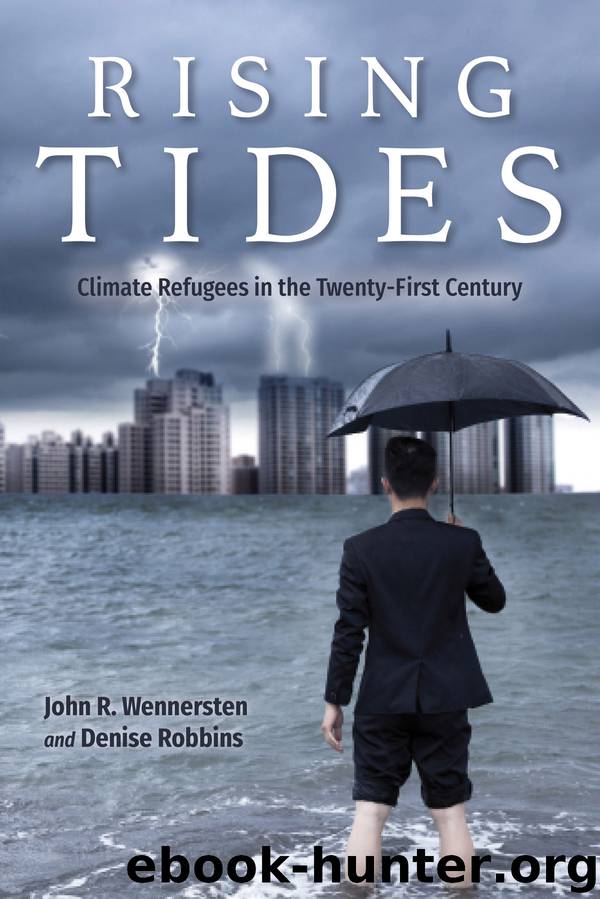Rising Tides by John R. Wennersten

Author:John R. Wennersten
Language: eng
Format: epub
Publisher: Indiana University Press
Published: 2017-04-04T04:00:00+00:00
AFRICA REFUGEES BY THE NUMBERS
Africa is already home to some fourteen million people worldwide displaced by political turmoil and war, but experts say climate change is driving Africa’s displacement crisis to new heights. An estimated ten million people worldwide have already been driven out of their homes by rising seas, rain, desertification, or other climate-driven factors.
The year 2014 saw a record number of displaced people, and a significant portion of the refugees were from Africa. A United Nations report found that 59.5 million people were forcibly displaced worldwide, the greatest increase in a single year. The report includes a frightening statistic: one in every 122 humans is either a refugee, internally displaced, or seeking asylum; the total number, if it constituted the population of a country, would be the twenty-fourth biggest population in the world. The UN reported that in 2014 the number of refugees in sub-Saharan Africa was only “marginally lower” than those from the Middle East. Sub-Saharan Africa saw 3.7 million refugees and 11.4 internally displaced people. Four and a half million of these were newly displaced during the year 2014 alone, the equivalent of a 17 percent overall increase.12
Many African countries comprise the world’s major source countries of refugees, including Somalia, Sudan, South Sudan, and the Democratic Republic of Congo (DRC).13 Of course, much of this is due to violent conflict in these areas. The UN report notes that eight violent conflicts have erupted in Africa in the previous five years—in Côte d’Ivoire, the Central African Republic, Libya, Mali, northeastern Nigeria, DRC, South Sudan, and Burundi. Somalia, a country that has not seen recent uprisings but is experiencing ongoing problems of drought and food scarcity, is also the third-biggest source of refugees.
Climate change is creating hardships for farmers, and combined with population growth this is creating a large migration from rural areas to urban. At least half the African population is expected to be living in cities by 2030 solely due to population growth and migration patterns.14 Climate change is expected to place even more stresses on agricultural life, further exacerbating the rate of urban migration.15 So although migration is not a physical impact of climate change, it is a societal impact that will need to be considered in the frame of context and refugees.
Download
This site does not store any files on its server. We only index and link to content provided by other sites. Please contact the content providers to delete copyright contents if any and email us, we'll remove relevant links or contents immediately.
| Anthropology | Archaeology |
| Philosophy | Politics & Government |
| Social Sciences | Sociology |
| Women's Studies |
The Secret History by Donna Tartt(18161)
The Social Justice Warrior Handbook by Lisa De Pasquale(11953)
Thirteen Reasons Why by Jay Asher(8451)
This Is How You Lose Her by Junot Diaz(6438)
Weapons of Math Destruction by Cathy O'Neil(5829)
Zero to One by Peter Thiel(5490)
Beartown by Fredrik Backman(5357)
The Myth of the Strong Leader by Archie Brown(5238)
The Fire Next Time by James Baldwin(5016)
How Democracies Die by Steven Levitsky & Daniel Ziblatt(4958)
Promise Me, Dad by Joe Biden(4908)
Stone's Rules by Roger Stone(4857)
100 Deadly Skills by Clint Emerson(4691)
A Higher Loyalty: Truth, Lies, and Leadership by James Comey(4550)
Rise and Kill First by Ronen Bergman(4545)
Secrecy World by Jake Bernstein(4388)
The David Icke Guide to the Global Conspiracy (and how to end it) by David Icke(4380)
The Farm by Tom Rob Smith(4323)
The Doomsday Machine by Daniel Ellsberg(4245)
